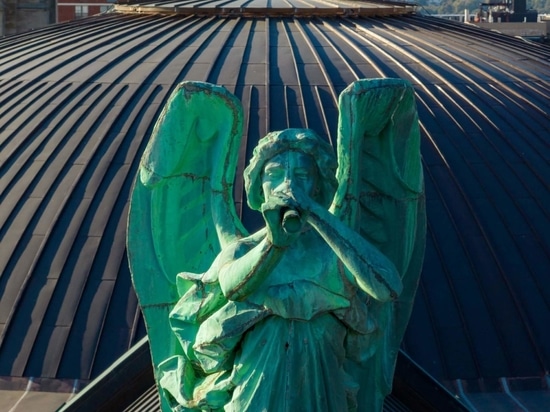
#PUBLIC ARCHITECTURE PROJECTS
Ennead Architects restores the dome at the Cathedral Church of St. John the Divine
The Cathedral Church of St. John the Divine, affectionately nicknamed St. John the Unfinished, remains without a spire, its south transept, and fully-realized towers. Construction on the cathedral for the Episcopal Diocese of New York, began in 1892 and only two-thirds of the church was ever completed. Still, the complex is making progress. The cathedral, which by some measures is the largest in the world, has just completed a three-year-long, $17 million renovation to repair its dome.
Ennead Architects, alongside structural engineers Silman; Building Conservation Associates; and James R. Gainfort Consulting Architects, have refaced and restored the dome, which was a 1909 addition from Spanish-American architect and master builder Rafael Guastavino. The rounded top was a provisional design element spanning over the church’s four granite arches, occupying the location of a spire that has not been realized.
Guastavino’s recognizable tilework designs can be found all over New York City: at the Registry Room at Ellis Island, in the Oyster Bar in Grand Central, and the underside of the Ed Koch Queensboro Bridge. When conceived by Guastavino in the early 20th-century, the dome was intended to be temporary. Originally built in granite with a terra-cotta underside, the dome spans over the intersection of the building’s four granite arches, an area defined as the Crossing. The interior of the dome was never an ornate affair: Rather, it was faced with concentric rings of terra-cotta tiles. In the years following its construction several proposals circulated to replace the rounded volume with a completed Crossing to be topped with a tower and spire. None of the proposals were built.
As a structure built for short-term use, it wasn’t long after its completion that the dome required maintenance and structural upgrades. The landmark cathedral has been troubled with the same issues for decades. Temperature fluctuations caused the dome to expand during hot weather and contract when the temperature dropped. This seasonal (and daily) shift gave way to cracking and water infiltration. Beyond this movement, two fires broke out within the church. In 2001 the blaze overtook the church gift shop and a part of the north transept, and in 2019 the flame broke out in the crypt but was contained.
Renovation efforts remedy these issues, by improving structural integrity while providing necessary thermal insulation and preventing water entry. Waterlogged insulation was removed, and tiles were allowed to dry out. The original tilework was evaluated, and damaged pieces replaced with new, custom-made ones from Sandkuhl Clay Works. The design team specified the installation of spray-foam insulation on the exterior surface of the structure to aid in thermal regulation.
Working on the dome required a careful balance between retrofitting for structural considerations and maintaining architectural quality and integrity. The tiled interior of the dome was restored and the new copper roof was added. This recent renovation marks the first time in decades that the terra-cotta work is visible. According to The Very Reverend Patrick Malloy, Dean of the Cathedral Church of Saint John the Divine, the tiles have been covered over by layers of “New York City soot, candle wax, and incense smoke,” blackening their appearance.
Ennead has a long history working with St. John the Divine. The firm has overseen the continued upkeep of the building and property, known as the Close. Its work has been consistently informed by the church’s mission and needs.
“It’s been our honor to work closely with the Cathedral of St. John the Divine for more than 30 years,” said Kevin Seymour, associate principal at Ennead Architects in a press release. “As with all historic buildings of this size, continued restoration is essential for the survival of the structure. By conserving the dome with consideration to authenticity, we are protecting the Cathedral’s rich history, supporting its ever-changing nature and extending its life as a metropolitan monument.”
“Working closely to align with the cathedral’s priorities and concerns, we were privileged to have contributed to the enduring design within this magnificent landmark,” added Charles Brainerd, senior associate at Ennead Architects. “Our restoration harmonizes with the designs from a series of other architectural authors in the Cathedral’s century-plus existence, further enriching and honoring its history while reinforcing its integrity.”
Copper on the newly refaced dome matches the copper used on the Cathedral’s choir and apse. The design utilizes a batten-seam copper roof construction, and the installation is laid out in a radial arrangement of rectangular copper sheets. The reddish-brown tone of the copper will patina to green over time matching the color of the longstanding angel Gabriel statue on the apse roof.
“This restoration is more than an architectural triumph. It restores for our visitors and all of us who worship and work at the Cathedral a sense of excitement and wonder, and a gratitude to our ancestors who were audacious enough to build the largest church in the United States here in Morningside Heights,” Reverend Malloy said.
The architects anticipate that with the right care the dome could last another 100 years. Whether a spire will ever rise atop the cathedral remains to be seen.





